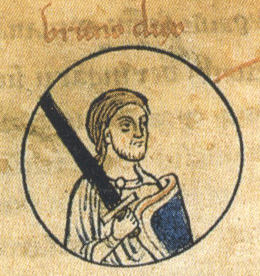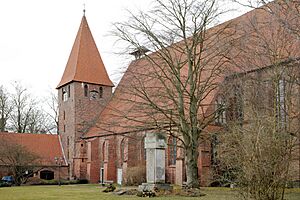Bruno, Duke of Saxony facts for kids
Quick facts for kids SaintBruno of Saxony |
|
|---|---|

Bruno dux, depiction in the Chronica sancti Pantaleonis (about 1237)
|
|
| Duke and Martyr | |
| Born | c. 830/840 |
| Died | 2 February 880 Battle of Lüneburg Heath |
| Venerated in | Catholic Church |
| Major shrine | Ebstorf Abbey |
| Feast | 2 February |
| Patronage | Brunswick |
Bruno, also known as Brun or Braun, was an important leader in a region called Saxony (part of modern-day Germany) from about 866 until he died in 880. He belonged to a powerful family known as the Ottonian dynasty. Bruno is remembered for bravely fighting against Viking warriors. He died in a big battle called the Battle of Lüneburg Heath and is honored as one of the Ebsdorf Martyrs, who were people killed for their faith.
Contents
Who Was Bruno of Saxony?
His Early Life and Family
Bruno was born around 830 or 840. He was the oldest son of a Saxon count named Liudolf. His mother was Oda of Billung. Bruno's father owned a lot of land in a region called Eastphalia, near the Leine river. In 852, his father started a monastery there called Brunshausen.
When his father died in 866, Bruno took over his position. By 877, he was known as a count. His family was becoming very important in a kingdom called East Francia. This was a large part of what is now Germany.
A Powerful Family Connection
Bruno's sister, Liutgard, married a prince named Louis the Younger in 874. Louis was the son of King Louis the German. This marriage made Bruno even more important. People started calling him "duke and the queen's brother." We don't know much about Bruno's own marriage or if he had any children.
Fighting the Vikings
Bruno supported his brother-in-law, Louis the Younger, in battles against Louis's uncle, Emperor Charles the Bald. Bruno became a main commander for the Saxons during the Viking invasions. These were times when Norse warriors, often called Vikings, attacked different parts of Europe.
On February 2, 880, a battle took place against these Viking warriors. It was likely a group of Danish Vikings. This battle, known as the Battle of Lüneburg Heath, was a terrible defeat for the Saxons. Many important people were killed.
Duke Bruno died in this battle, along with two bishops and twelve Saxon counts. A writer from that time, Bishop Thietmar of Merseburg, said that Bruno died in a flooded river. This might have happened during the battle or while trying to escape. After Bruno's death, his younger brother, Otto the Illustrious, became the new duke. Otto's son, Henry the Fowler, later became King of East Francia in 919.
Becoming a Saint
Bruno is honored as a saint and a martyr in the Catholic Church. A martyr is someone who dies for their beliefs. His feast day is celebrated on February 2, and he is known as St. Bruno of Saxony.
Around 1160, some of Bruno's relics (special items connected to a saint) were moved to Ebstorf Abbey. This abbey is near a town called Uelzen. From the 1300s, people believed that the 880 battle where Bruno died happened near Ebstorf. Because of this, Ebstorf Abbey became a very important place for pilgrimages. People would travel there to visit the holy site.
Some stories also say that Bruno founded the city of Brunswick. He is also thought to be an ancestor of a local count named Brun I. This count was a candidate for king in 1002. The similar names suggest they might be related. However, some records might be talking about an older Saxon leader named Brun the Younger, who could have been Bruno's grandfather.
See also
- Ebstorf Map
Sources
- Reuter, Timothy (trans.) The Annals of Fulda. (Manchester Medieval series, Ninth-Century Histories, Volume II.) Manchester: Manchester University Press, 1992.
|
Bruno, Duke of Saxony
|
||
| Regnal titles | ||
|---|---|---|
| Preceded by Liudolf |
Duke of Saxony 866–880 |
Succeeded by Otto I |


